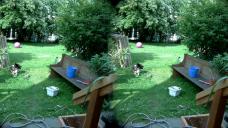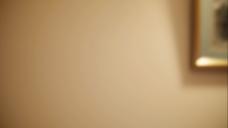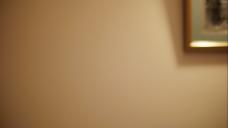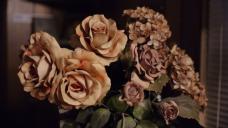
-
@fatpig Ive been trying to understand what the exact resolution required to pull it out under mjpeg mode without having to resize and be abe to play it straight back off the sd card plugged into a viera tv. Its unusable and yes very sad.
Barrry Green's article was fairy helpful but working out the dimensions pre NLE is taking a lot of testing. I think youre probably right even though its not an anamorphic lens (see lpowell and B Greens findings) there may well be a way of blowing it out properly. Presently its too wide so you mess with the vertical res and then you one image sitting inside the other.... tres difficult... looks like post is the only way to do it for now unless anyone can find a suitable adapter. -
I really don't know what you are seeing. look at the picture- straight out of the cam. look at the ball. this is the image the lens produces. there is no wrong aspect ratio in it. it is like this. 2 perfectly unstretched images side by side, but one not as large as the other one, due to mechanic incorrectness of the production process.
Nothing to stretch in post here.
 3dgh2.jpg1920 x 1080 - 438K
3dgh2.jpg1920 x 1080 - 438K -
@fatpig Try sticking it on a panny viera screen and its vertically squashed (side by side 3D). You can work on it in an NLE/post and sort it but I was attempting to change the sizing incamera so I didnt have to do that (of course this was purely for me and other viera/3D TV owners). We may need a new thread to discuss this further.
-
do you mean that the viera tv stretches it on its own?
-
I've been experimenting with small resolution increments, just for 16:9, which some seem to work so far without lowering the quality settings Driftwood provided.
The hope is, it down sizes from full size sensor image -> x by y, and stores that, so the idea is to shoot slightly wider than I need for the odd clip that I want to process through Deshaker for some more stability, so that it can crop without (or even less) loss of detail/sharpness for 1080p. -
Having the SLR-Magic 0,95 Lens for some days, I get problems with banding because of soft backgrounds and gradients. The 1920x1080 MJPEG Patch shows lesser banding compared to to the best AVCHD-Patch. I guess, it is because of higher noise. Almost no blocking/mudding in darker areas with MJPEG!! A BIG MUST: Having the ability to record 16bit PCM in 48.000kHz, or at least AC3. Quicktime player shows 16.000kHz sampling frequency in my MJPEG recordings. So audio is not usable. See: http://www.personal-view.com/talks/discussion/492/eoshd-crusade-on-mjpeg-hacks/p2 All the best, Frame
-
@Frame I can confirm - the MJPEG doesn't suffer of banding problem, as opposed to AVCHD. I've attached two sample screenshots (ISO 320, F0.95, intentional out of focus). I know, these are jpegs, but anyway. First one (Driftwood, GOP1, 174mbits/s) has concentric bands around the picture on the wall, and the second (MJPEG. 100mbits/s) one just doesn't have this problem at all. I think this is all about compression methods of the two very different formats. Previously I was really disappointed that even best available hack doesn't fix the banding issue that I face everytime when I shoot in the darker places with the smooth/gradient background. After I tried the Mjpeg mode I was really surprised in a good way. So here's the workaround for me. If I need to shoot in such environment as in the samples I'd use MJPEG, otherwise - AVCDH would be the choise, most of the time.

 gh2_dw_174_banding.jpg1366 x 768 - 71K
gh2_dw_174_banding.jpg1366 x 768 - 71K
 gh2_mjpeg.jpg1366 x 768 - 64K
gh2_mjpeg.jpg1366 x 768 - 64K -
Try some of the Quantum mjpeg settings but adjust the frame sizes back to 1920 x 1080 and 720 x 1280. See if you can get further improvements than the 100M setting you used.
-
@Euggie2000 are you saying in low light situations mjpeg has no banding?
-
@driftwood frames were 1920x1080, these pictures are the screenshots.. Which Quantum mjpeg settings do you recommend to adjust? I am curious if it's possible to raise DR, is there any way to get some kind of the effect in the Nostalgy mode. RED cameras shots show the better shadow details, is it because of the auto hdr shooting?
-
@kenoah in low light banding is either absent or very low compared to AVCHD mode.
-
@euggie2000 The patch parameters in the Flow Motion 100Mbps MJPEG patch were optimized to maintain high bitrates even in low light conditions, which makes it very good at minimizing banding in areas of dimly lit gradients. One of the best tools for evaluating MJPEG image quality is JPEGsnoop:
http://jpegsnoop.en.softonic.com/
The GH2 records a JPG screenshot file along with each MJPEG MOV file. If you drag the JPG into JPEGsnoop, it will reveal the Quantization Tables used to compress the macroblocks in the file. Here's the luminance table the GH2 used to encode the low light sample video screenshot below, which was recorded with an average bitrate of 88Mbps:
02 02 02 02 07 05 11 11
02 02 02 02 05 09 11 11
02 02 05 05 05 09 16 14
02 05 05 07 11 14 20 20
02 05 07 11 14 16 11 23
09 07 11 14 16 20 16 20
05 14 18 16 20 23 20 18
14 16 18 18 23 23 20 20
The most important numbers in this table are in the upper left corner, and are used in quantizing the most prominent details in the image. Smaller numbers produce higher quality details, but require higher bitrates to encode. For comparison, here's the luminance quantization table Photoshop used to encode the same JPG at its Maximum quality setting:
02 02 03 04 05 06 08 11
02 02 02 04 05 07 09 11
03 02 03 05 07 09 11 12
04 04 05 07 09 11 12 12
05 05 07 09 11 12 12 12
06 07 09 11 12 12 12 12
08 09 11 12 12 12 12 12
11 11 12 12 12 12 12 12
These tables are very similar, indicating that the 100Mbps MJPEG patch can produce videos in low light that are comparable to maximum-quality Photoshop JPEG's.

 Flow Motion 100Mbps MJPEG Patch.JPG1920 x 1080 - 389K
Flow Motion 100Mbps MJPEG Patch.JPG1920 x 1080 - 389K -
@LPowell Thank you for the explanation! Oh, does this MJPEG tunning also improve the photo JPEG quality? Or is there a way to do this? Because many people complaining that the camera JPEG is not too good.
-
No, the MJPEG patch settings are completely separate from the camera's still photo JPEG settings. I recommend shooting stills in RAW mode.
-
Second this! If you have RAW, why not shoot RAW? Compared to high-rate video, the space needed is still small…
-
It is possible to create in the wiki a GH2 Hacking FAQ for the Mjpeg? A setting scheme like it exist for the AVCHD will be for the newbies of the Ptool like me very usefull. (I decided to wayt for the 1.1 version before playing around). Would be nice to have the timelapse settings too.
-
Its quite straightforward, but yes a wiki from the testers will probably appear soon. Take a look at Lpowells low light setting which are good or my higher bitrate/quality mjpeg settings in some of the Quantum patches (dont forget to put it back to 720 width/height =1920 x 1080 and 480 width and height =1280 x 720). Basically you have four tables for Quality (bitrate) and four tables for, well, Quantisation.
My hunch has been that E1/F1 pushes Q chrominance and E4/F4 pushes Q luminance. Lessen the table values for better Quantisation (closer to 0 is better quality low compression but requires more bitrate in Quality setting, higher table values = higher compression, poorer quality but uses less bitrate).
Judge allocating bitrate in the quality settings according to how low your tables go. Too high on the Quality bitrate/low on the tables will hinder recordings/stop them prematurely.
Use jpegsnoop (search google for downloadable proggie) to look at the jpegs produced by the GH2 (when you hit record in mjpeg mode a first frame snapshot is produced - analyse this jpeg with jpegsnoop to see the quality/quant info).
If your recording never gets past the snapshot youre using too low a table setting/too high a Quality setting! Good luck!
-
Are these settings compatible with 1.1 and v3.64d?
-
@csync Yes, and these same 100Mbps MJPEG settings are included in Flow Motion v1.1
-
Fantastic, thanks for all of your help!
-
Hey,
i've a question. I use a 1.33x adapter and your anamorphic patch. For me, it seams like the image is much noisier than before.
I read somewhere, that this is "normal" and i have to reduce the noice later with my editing program (i just have premiere pro). Is that right or wrong? Sorry if im asking stupid questions.
Please check my video:
Also, i dont 100% the advantage of using MJPEG instead of AHVCD 24p mode (which is much more cinematic) - is there an easy explanation why i should use MJPEG?
Isnt it better to do the post processing (in example exporting the image in 1080p, 1.33 PAR via Adobe Premiere Pro) than let it be done by the camera (cropping the picture to 1920x810).
Hope this is the right place to ask this kind of questions.
Best regards Emin
-
@eminogrande At ISO 3200 on either the GH1 or GH2, MJPEG is definitely going to be noisy. With an anamorphic adapter, I'd recommend shooting at ISO 800 or less.
MJPEG 1.33x anamorphic mode has two advantages over post-processing 24p anamorphic footage:
Convenience - the camera does the 1.33x horizontal stretch, producing square pixels natively.
Compression quality - the camera stretches the frame before it's encoded into MJPEG format. The drawback of stretching the frame in post is that you're working with compressed 8-bit color data.
-
Thanks a lot @LPowell - i guess i "just" trust you in that. I basically get both points. I will try to use 800 ISO or less for my next shots and post the result here.
best regards emin
-
@LPowell is there a flow motion patch including the anamorphic 1.33 so i can play around with 24p and mjpeg 30p mode - both with peak 100mbps?
-
I did some tests and it seems that Gh2 use for .mov files rec601 (SD) not rec709 (HD) color profile. I heve not tested vimeo but I not think they use rec601. The computers and I think the new plasma, led and lcd tv with HD uses rec709. Rec 601 is standard for < 720p , Rec 709 is for > 720p. So this is a bug in GH2 camera. (Is possible in post-production to convert from one to another.) Maybe we will see a hack which has MJPEG 4:4:4 and Rec 709.
Howdy, Stranger!
It looks like you're new here. If you want to get involved, click one of these buttons!
Categories
- Topics List23,979
- Blog5,725
- General and News1,352
- Hacks and Patches1,153
- ↳ Top Settings33
- ↳ Beginners255
- ↳ Archives402
- ↳ Hacks News and Development56
- Cameras2,362
- ↳ Panasonic991
- ↳ Canon118
- ↳ Sony156
- ↳ Nikon96
- ↳ Pentax and Samsung70
- ↳ Olympus and Fujifilm100
- ↳ Compacts and Camcorders300
- ↳ Smartphones for video97
- ↳ Pro Video Cameras191
- ↳ BlackMagic and other raw cameras116
- Skill1,961
- ↳ Business and distribution66
- ↳ Preparation, scripts and legal38
- ↳ Art149
- ↳ Import, Convert, Exporting291
- ↳ Editors191
- ↳ Effects and stunts115
- ↳ Color grading197
- ↳ Sound and Music280
- ↳ Lighting96
- ↳ Software and storage tips267
- Gear5,414
- ↳ Filters, Adapters, Matte boxes344
- ↳ Lenses1,579
- ↳ Follow focus and gears93
- ↳ Sound498
- ↳ Lighting gear314
- ↳ Camera movement230
- ↳ Gimbals and copters302
- ↳ Rigs and related stuff272
- ↳ Power solutions83
- ↳ Monitors and viewfinders339
- ↳ Tripods and fluid heads139
- ↳ Storage286
- ↳ Computers and studio gear560
- ↳ VR and 3D248
- Showcase1,859
- Marketplace2,834
- Offtopic1,319





